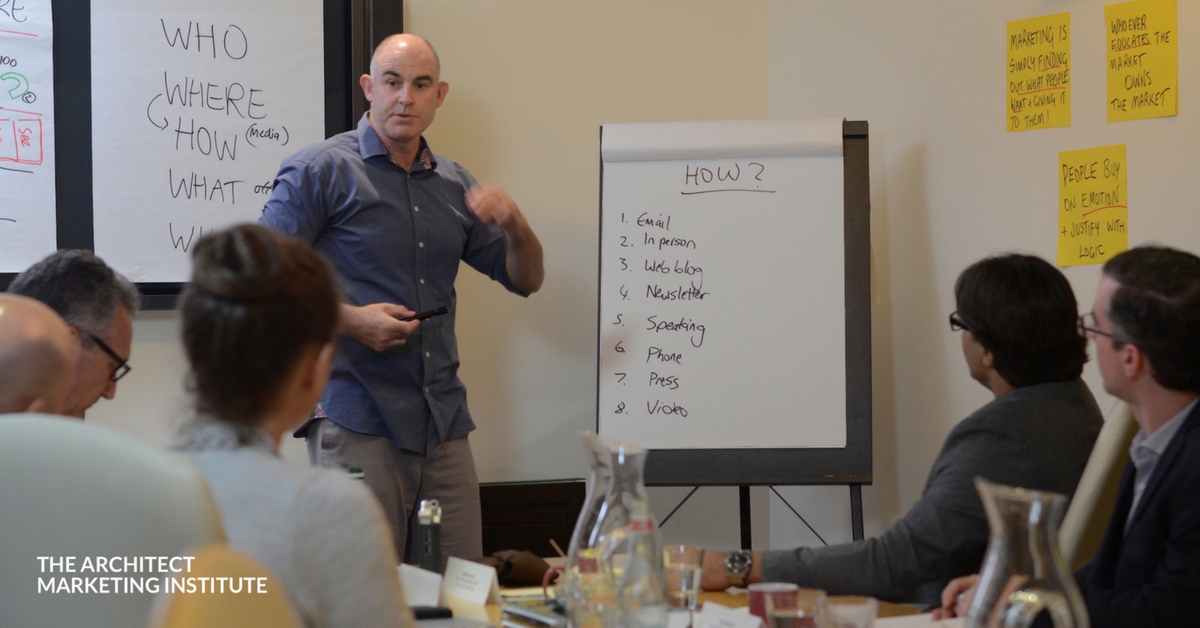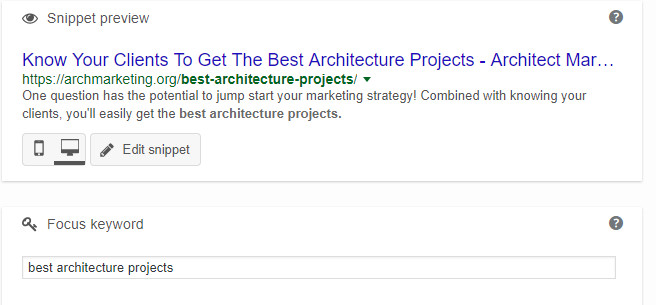
Although SEO for architects (or learning how to optimize a blog post) can sound daunting, there are seven essential elements you can implement immediately to begin ranking in search engines and grow traffic (more prospects) to your blog. Even if you aren’t ranking on page one (or even fifty) on Google, these methods will get you well on your way.
First, it’s important to understand on-page search engine optimization (SEO) and how it affects website traffic.
SEO For Architects: What Is It?
Search engine optimization is the process of increasing organic website visibility within search engines. Simply put, on-page optimization helps search engines to recognize your site and rank it, which will increase your traffic.
Think of your website as a physical business location.
Just like you would put up a sign advertising your location, search engines and optimization work to make your website easily discoverable. By optimizing your website for search engines, you are effectively putting up a sign saying, “Here I Am!”
Google's mission is to make the world's information universally accessible and useful. They achieve this by sending out robots to crawl websites and evaluate key elements, such as on-page SEO, which are then ranked on the search engine results page (SERP) to provide the most relevant results to users.
The better your optimization and content, the higher your ranking will be.
Keywords play a crucial role in the search and optimization process. People enter specific words or phrases into the Google search bar to find information, and websites can specify keywords for each page or blog post to increase their chances of being discovered through those searches.
Make sure to include relevant keywords to help boost your website's visibility and attract potential architecture clients.
Seven Elements of SEO for Architects
Now that you understand SEO for architects a little better, let’s discuss the eight essential elements that should be included in your blog post optimization strategy.
Unique Keyword
Keywords have a dual purpose online, as they are used to find information for users and are provided by websites to outline the type of content provided. In regards to blog post optimization, it’s important to discover what keyword or keyword phrase your target market would be searching for.
As an example, your potential clients may search the phrase, ‘What to ask when hiring an architect.’ In this case, keyword research would indicate that an appropriate keyword phrase would be ‘hiring an architect.’ Once you have a keyword, then you build content around it. The keyword you've decided on is added to the section entitled, ‘Focus Keyword,' in WordPress.
PRO TIP: Each blog post and/or page on your website must have a unique keyword. If you duplicate a keyword on your site, then you will be competing for rank against yourself and probably won’t rank at all.
Content
Seo for architects starts with finding the right keywords for your target market. After identifying the right keywords, the next crucial aspect is to post high-quality content. It should be easily read and original. Not even the best optimization can save low-quality content. In regards to length, all posts should be at least 350 words. Actually, longer is always better.
As a general rule, each keyword or phrase should be smoothly incorporated into your content around three to four times in each 100 words of text. Going over that percentage could negatively impact your ranking. This is called ‘keyword saturation.’ Google will count it as a strike against you.
PRO TIP: Also, include at least one subheading (H2) within the text that includes your keyword. On WordPress, you’ll see a box on the menu bar with ‘paragraph style’ options like ‘normal text’ (the default), title, subtitle, etc. Highlight your subheadings and click on ‘heading 2’ for improved SEO.
Title
An important aspect to blog post optimization is deciding on an effective title. The blog post title should be dynamic, eye-catching and include your keyword(s). Think about the titles of emails coming to your inbox (as you'll want to share these posts). It's always more compelling when you can read the whole title.
URL
Also known as a slug and permalink, the URL is the end of the website address that directs Google and visitors to the correct page. What a lot of people (and most architects) don’t realize is that you can edit the URL of your blog post to make it easier to find. This also helps to further optimize your site when it includes your keyword or keyword phrase.
PRO TIP! This is the specific address to your post. You will find it at the top of the ‘new blog post’ form that you set up to post a blog on WordPress. Keep the slug as short and concise as possible. (Example: www.myblog.com/hiring-an-architect and see picture below)
Meta Tag/ Description
Under the ‘Tags' and ‘Category' sections, you can enter words and phrases that relate to the content. No need to repeat tags, as this is just a quick opportunity to give an overview of the page.
The Meta Description is an overview of your page as seen on search engine results pages. When doing SEO for Architects, once you enter keywords into a search engine, a list of relevant search results will pop up. You’ll notice that each result includes the title with a short description of the content underneath. That information is called the Meta Description. It’s basically a summary of your post, consisting of 165-175 characters. On WordPress, you’ll enter that summary in the ‘Snippet Preview' field under the text. This is your opportunity to engage the user with interest and encourage click-through. Again, be sure to include the keyword(s).
PRO TIP: The meta tag/description defaults to the first lines of your post text if you don’t enter something specific. So make sure to add your own summary, because the opening lines are not often adequate for architect blog post optimization. You want the reader to feel compelled to click and read more to see the rest of the story.
See the picture below to better understand the meta description.
Internal Links
Include links to relevant content on your site within the text by adding a hyperlink. Feel free to link outside of your site, as well, if you find relevant content somewhere else.
Image Alt Text
Blog posts with images get more clicks! Be sure to include a great ‘featured image’ as your main photo and, for longer posts, use a second picture in the body of the blog text.
PRO TIP: After adding the photo, you can click to edit it and add the keyword phrase and information in the Alt Text field. As an example, if your image is of a woman talking to an architect, your alt text could be ‘woman hiring an architect.’ If the photo is of one of your projects, use your keywords along with a location, such as ‘new kitchen Belmar New Jersey’ or ‘modern beach home South Carolina.’ (Because Google gives results based on location, too!)
SEO For Architects Takes Time
SEO For Architects and blog post optimization isn’t easy, especially when done correctly, but the benefits far outweigh the initial headaches once you get the hang of it.
For more information on the importance of internet marketing, check out the following video: Internet Marketing for Architects, which was created by architect marketing experts Enoch Sears and Eric Bobrow.
It's important to remember that SEO/optimization is a marathon, not a sprint. Once you complete the required SEO for architects optimization steps above, all of your hard work and patience will most definitely pay off. To go back to the beginning and learn about architect marketing, visit our post on the diamond strategy.
Feel free to comment with any questions. We'll be happy to help!



Your article is very good very practical, I will collect up, hope you can also pay attention to my web site, thank you very much!
Thanks, Michael. I’m glad we can inspire you to re-think SEO on your website. Our community of architects talks a lot about how they implement these strategies and get their voices heard and websites found. For more practical methods and strategies to get your design firm noticed and attract more clients and projects, register for our online master class at https://archmarketing.org/webinar
We’re so glad to hear that, Roland. It is amazing what SEO can do to drive traffic to your site … and ultimately, help you connect with your ideal clients. Let us know what else you learn that you find helpful!
Just what I was looking for. A good article on SEO and found it! Thanks Michelle! My 11th week into AMI and learning a wealth of information.